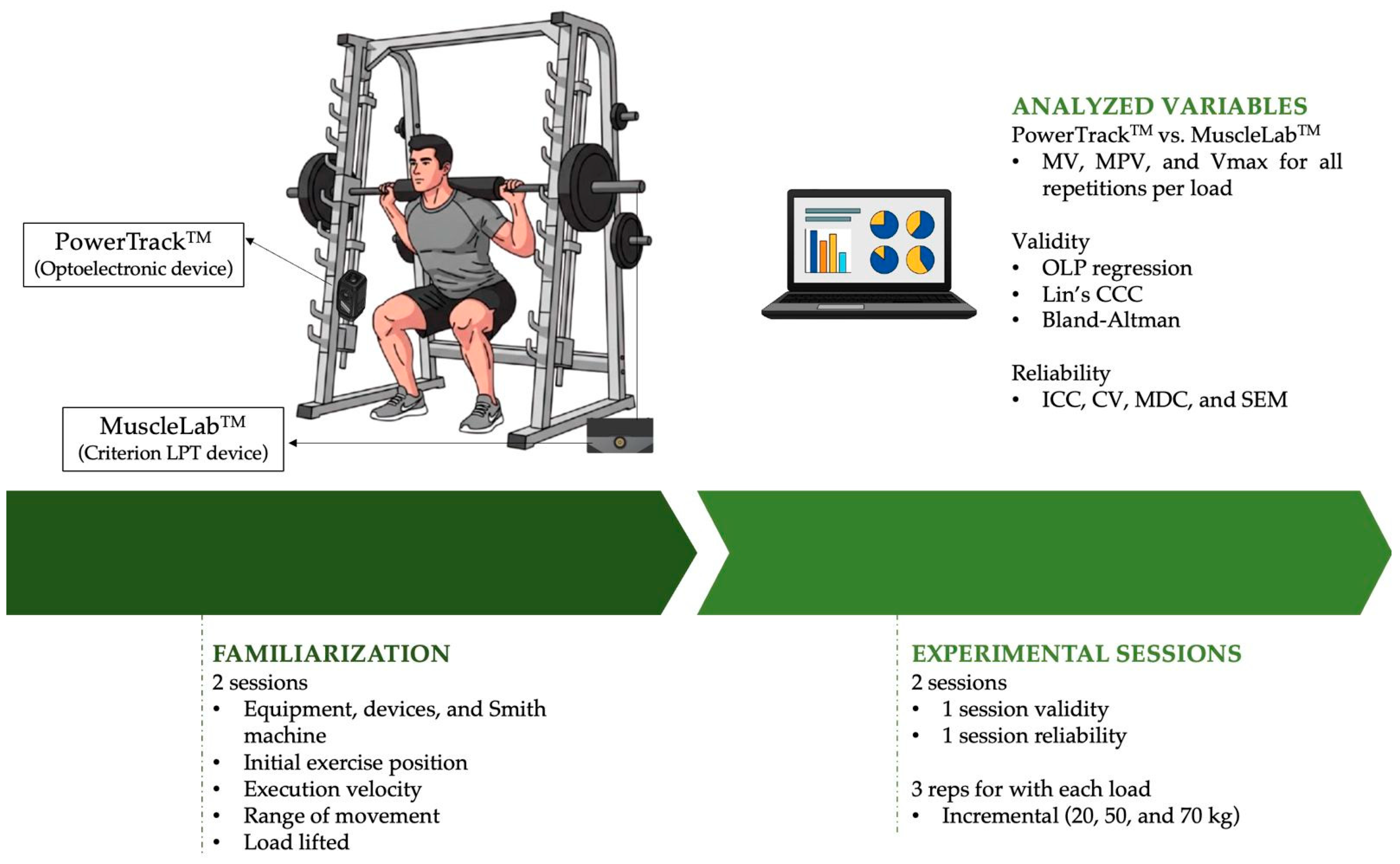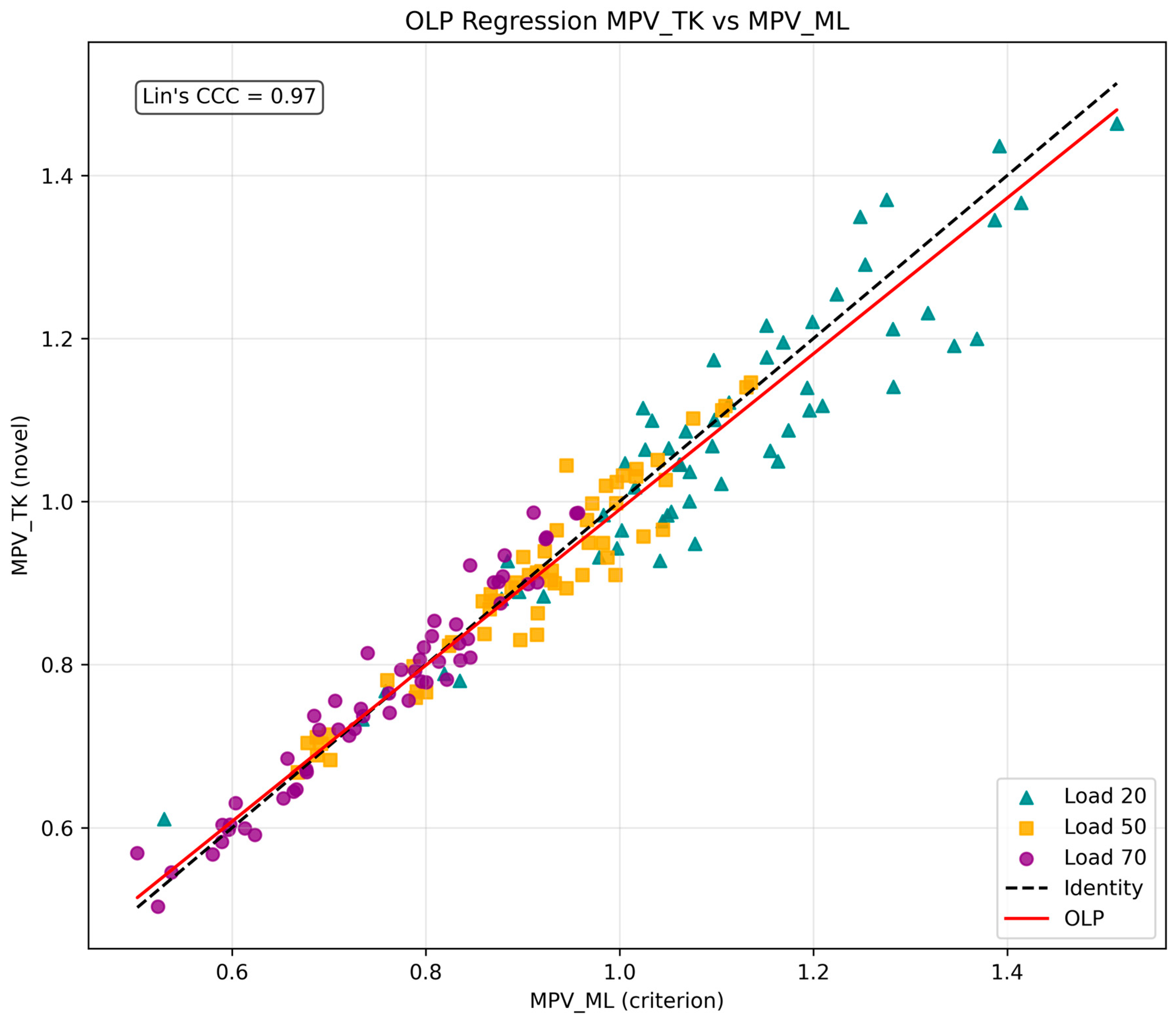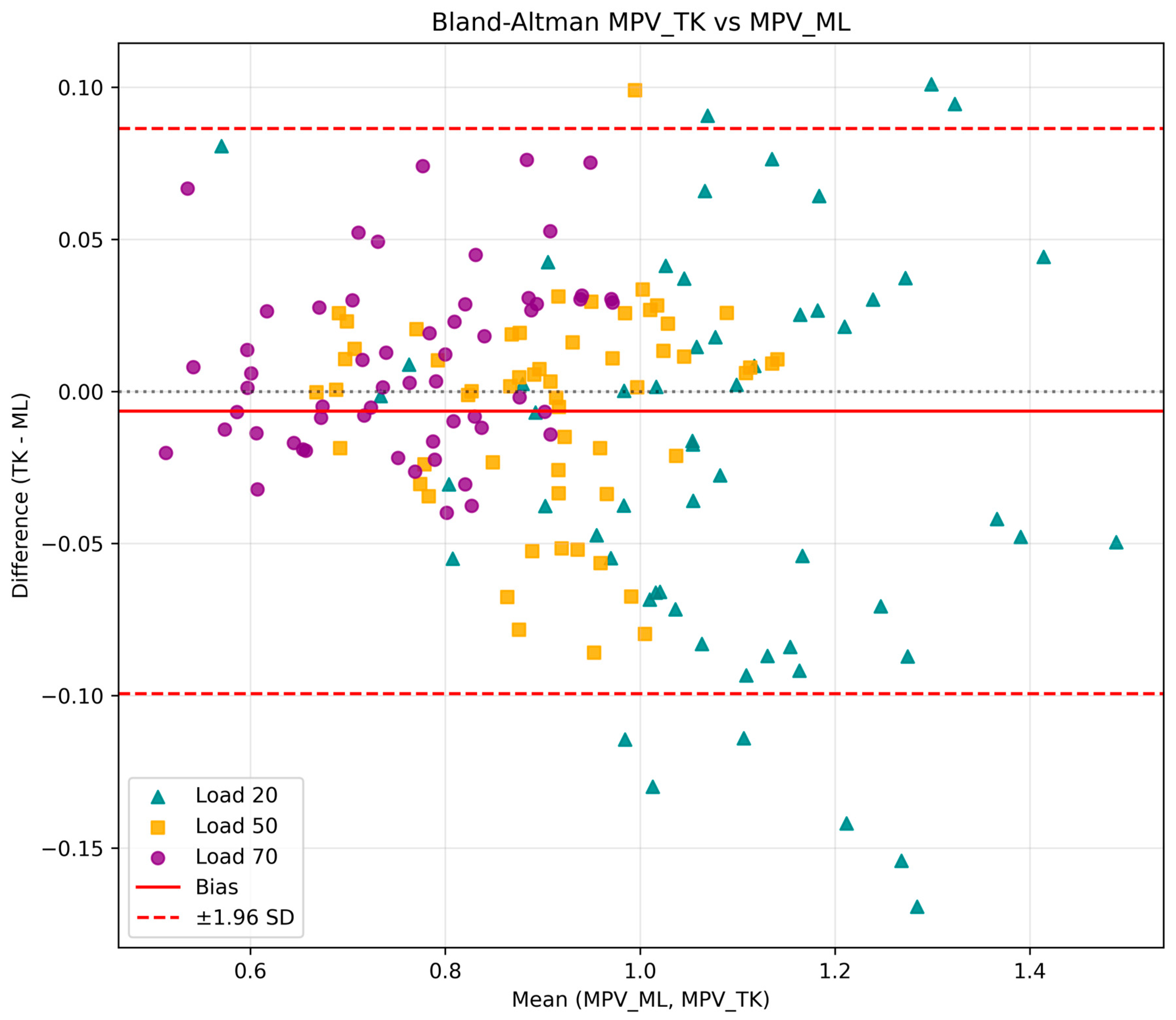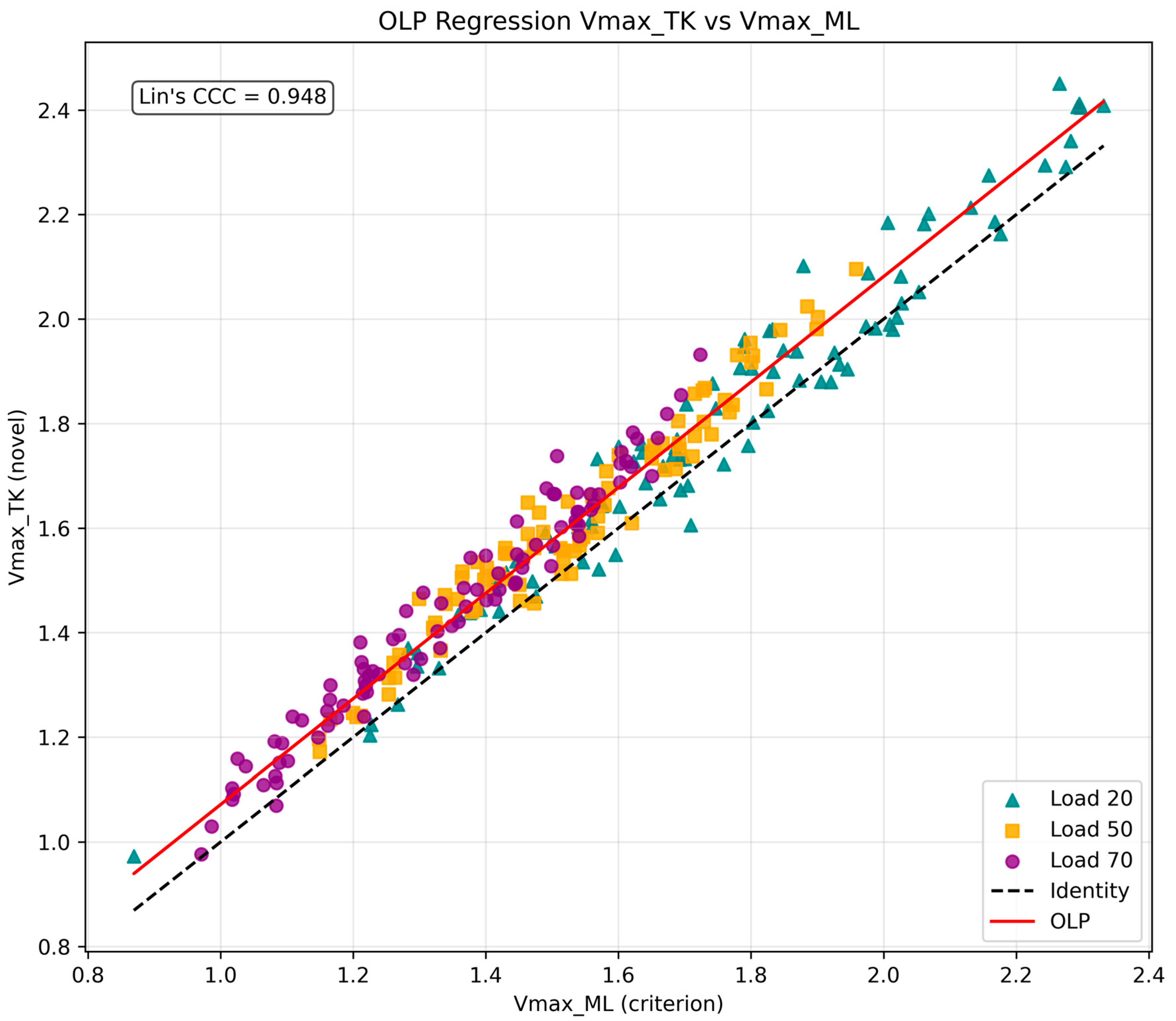1. Introduction
Muscular strength constitutes a determinant of athletic performance, particularly in explosive actions such as jumping and sprinting [
1]. This is primarily because mechanical power—defined as the product of force and velocity—depends on both maximal and relative strength levels [
2]. In this context, velocity-based assessments enable the simultaneous quantification of force and velocity, providing a valid and direct estimate of an athlete’s mechanical capacity while overcoming the inherent limitations of traditional indirect methods. A central application of this approach is the construction of the force–velocity (F–V) profile, which serves as a valuable tool for detecting mechanical imbalances and informing the prescription of individualized training strategies [
3]. Additionally, specific neuromuscular metrics, such as rate of force development (RFD) and movement velocity, have shown strong predictive value for sports performance [
4]. Although field-based estimations of one-repetition maximum (1RM) are commonly employed, they tend to exhibit lower accuracy compared to velocity-based methodologies [
5]. Consequently, precise assessment of muscular strength and its dynamic derivatives is essential for the effective design, monitoring, and optimization of training programs tailored to the athlete’s specific needs [
6].
The load–velocity relationship observed during resistance exercise is typically linear and inverse such that movement velocity decreases as external load increases [
3]. This relationship is consistent, exercise-specific, and demonstrates strong linearity (R
2 > 0.95), enabling precise estimation of relative load (%1RM) based on concentric movement velocity [
5]. Within this context, several velocity metrics have been identified as relevant for monitoring performance, including mean velocity (MV), mean propulsive velocity (MPV), and maximum velocity (Vmax). Among these, MV offers the most stable predictive capacity for estimating %1RM across a wide range of loads. However, MPV may be more sensitive at lower loads by excluding the deceleration phase, thus better reflecting neuromuscular output [
7,
8]. This foundational relationship underpins the implementation of velocity-based training (VBT), a methodological approach that facilitates real-time load prescription, fatigue monitoring, and dynamic adjustment of training parameters according to individual responses [
2].
Traditional resistance training (RT) intensity prescriptions are primarily based on the 1RM, either directly assessed or indirectly estimated via using percentage-based approaches [
5]. While valid, direct 1RM assessment is time-consuming, induces fatigue, and fails to account for daily neuromuscular variability, thereby limiting its practicality for frequent monitoring [
1,
9]. In response to these limitations, VBT has emerged as a viable, non-fatiguing alternative by leveraging the load–velocity relationship to estimate 1RM and regulate training intensity in real time [
1,
2]. Beyond load prescription, VBT also provides a sensitive marker of neuromuscular fatigue through intra-set velocity loss, thus offering a dynamic indicator of performance decline within a session [
7]. However, its validity depends on the measurement device, with linear position transducers (LPTs) generally demonstrating superior accuracy compared to some inertial sensor systems [
10,
11]. Overall, VBT facilitates more efficient and individualized training control, mitigating the drawbacks associated with conventional maximal strength testing [
6].
Various technologies are available to assess movement velocity during RT, each varying in accuracy and applicability. Among these, LPTs such as the MuscleLab
TM are considered the gold standard for measuring barbell displacement and velocity, particularly in exercises with vertical movement trajectories [
8,
9]. Inertial measurement units (IMUs), including the PUSH Band and Beast Sensor, offer enhanced portability. Recent research has also demonstrated the potential of high-frequency IMUs in complex dynamic tasks, further enriching the landscape of motion analysis technologies [
12]; however, their validity tends to decline under high-speed or high-load conditions [
13]. Optical systems, comprising laser- and camera-based devices (e.g., Velowin, Perch), provide high-reliability, contact-free velocity data across diverse settings [
2,
14]. Smartphone applications represent a highly accessible and low-cost alternative; nonetheless, many lack sufficient accuracy for scientific evaluation [
11]. Additionally, force platforms—traditionally employed to assess ground reaction forces—can be integrated with motion-tracking devices to yield estimates of mechanical output and power during dynamic tasks [
1]. Therefore, the selection of a measurement device should be guided by a careful consideration of its technical accuracy, contextual applicability, and economic feasibility [
9].
This study aims to validate PowerTrackTM, a novel sensor designed to measure movement velocity during resistance training exercises. The primary aim is to determine its validity and reliability by comparing its performance against a recognized criterion reference (the MuscleLabTM system) during the squat exercise, while also assessing its operational functionality and software interface. Given the increasing use of VBT as a less fatiguing and more adaptive alternative to traditional 1RM testing, PowerTrackTM is hypothesized to exhibit high accuracy and consistency, supporting its applicability in performance monitoring.
2. Materials and Methods
2.1. Experimental Approach to the Problem
This study was designed to explore the reliability and validity of the PowerTrackTM optoelectronic device for the measurement of three velocity variables (MV, MPV, and Vmax) during the back squat in Smith machine. Participants were evaluated in a double session through an incremental loading test (three loads: 20, 50, and 70 kg). They performed three repetitions with each load. All repetitions determined separately for each device (MuscleLabTM and PowerTrackTM), velocity variable (MV, MPV, and Vmax), and load (20, 50, and 70 kg) were employed for reliability analyses.
It is important to acknowledge that selecting the repetition that maximizes performance for a specific variable—such as the repetition with the highest MV—and system (e.g., MuscleLab
TM) could have artificially increased the reliability compared to the other variables and system. To avoid this bias, all repetitions per load recorded by MuscleLab
TM were employed. Consequently, the same repetitions data were employed to assess the concurrent validity of PowerTrack
TM.
Figure 1 details the study design.
2.2. Participants
Twenty physically active men [age = 36.80 (8.23) years; height = 1.72 (0.07) m; weight = 74.36 (8.35) kg; body fat percentage = 18.59 (7.46)%] participated in this study. Participants were recruited from a fitness center and were all previously familiarized, for at least 1 year, with the back squat exercise to ensure proper technique and execution during testing. Despite their prior experience, two standardized familiarization sessions were conducted to ensure participants were fully acquainted with the materials, devices, and Smith machine, including correct initial position of the exercise; prescribed movement velocity and range of motion; and the external loads to be mobilized. Eligibility criteria included the absence of any physical limitations, musculoskeletal injuries, or health conditions that could potentially compromise performance outcomes. Prior to participation, all participants received detailed information regarding the procedures and provided written informed consent. The study was conducted in accordance with the Declaration of Helsinki and was approved by the Ethic Committee of the University of Valencia (reference: 2024-FIS-3642443).
2.3. Testing Procedures
The MV, MPV, and Vmax of the barbell were simultaneously recorded by the MuscleLab
TM and PowerTrack
TM devices. A dynamic measurement system was fixed to the right side of the barbell with a tether and reported its vertical instantaneous velocity at a frequency of 200 Hz. This device consists of a linear velocity transducer interfaced with a personal computer employing a 14-bit resolution analog-to-digital data acquisition board and custom software [MuscleLab
TM (Ergotech Innovation AS, Stanhelle, Norway)]. The high reliability and validity of the MuscleLab
TM system has been reported elsewhere [
15].
PowerTrackTM (Tratech Technologies, Alicante, Spain) is a high-precision optoelectronic device for measuring resistance training variables (velocity, power, acceleration, displacement) via a contactless optical sensor. Unlike cable-based encoders, it reduces errors from friction or movement constraints. Easily attachable to plate-loaded machines via magnet, it provides reliable real-time tracking without mechanical interference. Furthermore, its software offers individualized feedback and supports continuous data logging for goal-oriented programming.
Technically, PowerTrackTM integrates a configurable time-of-flight (ToF) laser-ranging sensor that allows adjustment of both sampling frequency and measurement range, enhancing its adaptability to various biomechanical conditions. The sensor supports sampling rates of up to 50 Hz and operates across multiple modes: short range (~1.3 m) with sub-millimeter resolution (0.25 mm), medium range (~3 m), and long range (~4 m) with optimized signal processing. This flexibility enables users to prioritize either temporal resolution or spatial range, depending on the specificity of the movement task. In contrast to the MuscleLabTM system, which functions at a fixed 200 Hz and requires digital filtering, PowerTrackTM provides direct outputs wihout the need for signal smoothing, ensuring consistency with raw biomechanical data. Regarding precision, the manufacturer reports an absolute ranging accuracy of ±3% under calibrated conditions and a typical resolution of 1 mm in high-precision settings. While PowerTrackTM uses a ToF laser principle rather than an LPT, its ability to adjust acquisition parameters represents a notable advantage for tailoring measurement conditions in experimental and applied sport science contexts.
The back squat technique involved participants standing with the knees and hips fully extended, feet approximately shoulder-width apart, and the barbell of Smith machine held across the top of the shoulders and upper back. Thereafter, participants initiated a downward movement until reaching 90° of knee flexion, guided by a mechanical stop to ensure consistent range of motion during the eccentric phase. The concentric phase was performed at the maximal intended velocity to ensure that correct technique was maintained and participant safety was not compromised.
2.4. Statistical Analysis
All study variables (MV, MPV, and Vmax) were normally distributed according to the Kolmogorov–Smirnoff test. The concurrent validation of PowerTrack
TM versus the criterion measure LPT (gold standard) was assessed using ordinary least products (OLP) regression [
1]. Lin’s concordance correlation coefficient (CCC) was also employed to assess concurrent validity between devices [
16]. The criteria used to determine the strength of CCC were “almost perfect”, > 0.99; “substantial”, between 0.95 and 0.99; “moderate”, between 0.90 and 0.95; or “poor”, <0.90 [
11]. Additionally, Bland–Altman plots were used to assess systematic bias and 95% limits of agreement between both systems [
17]. Reliability was evaluated by the standard error of measurement (SEM), and the intraclass correlation coefficient (ICC), and the coefficient of variation (CV) values reported in our study correspond to inter-session variability, calculated from measurements obtained across two separate testing sessions. Acceptable reliability was determined as an ICC > 0.70 and an SEM < 0.20 [
18]. The minimum detectable change (MDC) was calculated as an indicator of sensitivity using the following formula (√2 × SEM × 1.96) [
19]. All statistical analyses, and accompanying plots, were performed using Python 3.12 software (Python Software Foundation, Beaverton, OR, USA).
4. Discussion
This study aimed to validate PowerTrackTM for measuring movement velocity during Smith machine squat exercises. Compared with the criterion device (MuscleLabTM), PowerTrackTM demonstrated excellent validity—evidenced by OLP intercepts ranging from 0.07 to 0.13 and slopes between 0.83 and 1.01—and high reliability across key velocity metrics, including MV, MPV, and Vmax (ICC > 0.80, and SEM < 0.09). Although a slight proportional bias was observed in the estimation of VM, this did not compromise the overall measurement accuracy. These findings support PowerTrackTM as a valid and consistent instrument for real-time monitoring of neuromuscular performance, offering the added advantage of mobile compatibility for field-based applications.
In VBT, the CV is commonly used to assess repetition-to-repetition variability [
20]. LPT systems (e.g., T-Force) often report higher CVs at lighter loads (e.g., 20 kg), suggesting reduced precision at higher movement velocities [
2]. This trend was also observed in our study, where CV for MV was highest at 20 kg (13.20%) and progressively decreased with heavier loads—to 11.34% at 50 kg and 10.43% at 70 kg. These divergent patterns reflect the interplay between technological error and biological variability [
8,
20], the latter including fluctuations in physical readiness, mental state, and technique [
8,
20]. Notably, participant-related variability often exceeds device-specific error [
21], underscoring the importance of distinguishing both sources when assessing measurement reliability [
8].
The present study demonstrated that PowerTrack
TM exhibited a proportional bias in MV (OLP slope < 1.00); this may be partially influenced by the inherent biological variability of human execution, particularly under light loads (e.g., 20 kg). Under these conditions, participants tend to maximize acceleration, which elevates velocity and amplifies biological variability due to psychophysiological factors (e.g., fatigue, motivation), motor noise (e.g., velocity fluctuations, tremors), and mechanical imperfections (e.g., bar path deviations, postural adjustments) [
8,
20,
21], even in controlled settings like the Smith machine. This variability, intrinsic to voluntary movement, cannot be fully controlled—unlike electronic motor-based validations that eliminate movement inconsistencies, this approach allows for a more precise estimation of the device’s intrinsic error [
22]. Such dispersion may hinder the optoelectronic system’s ability to accurately capture velocity peaks, thereby explaining the systematic underestimation of high-velocity values. Furthermore, the presence of proportional bias (slope = 0.83) in the OLP regression indicates that one system—specifically, PowerTrack
TM—tended to underestimate MV values, particularly at higher velocities induced by lower loads. This bias increases proportionally with the magnitude of the measured variable, which can have relevant implications in VBT settings where precise velocity prescription is required under low-load, high-speed conditions. Notably, studies such as that carried out by Ruiz-Alias et al. [
23] reported significant proportional bias in velocity measurements at low loads (20–60% 1RM), attributed to greater biomechanical variability (e.g., trajectory, technique, acceleration), which aligns with the underestimation of velocity peaks observed in our study. These findings suggest that human biological variability contributes to proportional bias beyond the technical limitations of the device.
These findings are consistent with the previous literature reporting similar bias in other validation devices. For instance, the Velowin system (optoelectronic) showed heteroscedasticity and systematic Vmax underestimation [
2]; PUSH Band and Vmaxpro (IMU-based) presented increasing errors of overestimation of MV at higher velocities [
13,
15]; ADR Encoder and MuscleLab
TM (LPT-based) displayed velocity-dependent bias patterns, especially for MPV [
15,
24]; even GymAware (LPT-based) has overestimated MV during squat exercises [
15]. Nevertheless, the findings support PowerTrack
TM as a valid and reliable alternative for VBT across a wide range of loads and velocities.
PowerTrack
TM’s strong validity and reliability support its application as an accessible and practical tool for VBT. In this study, the Smith machine squat was selected due to its proven effectiveness in developing lower body strength [
2] and its mechanically constrained vertical bar path, which minimized friction and horizontal displacement [
11,
25]. This setup reduces measurement variability—a critical requirement in validation protocols [
25,
26]. In contrast to free-weight squats, which permit greater movement freedom but introduce higher variability [
2,
15,
23], the Smith machine provides a more controlled environment, thereby enhancing measurement precision [
25]. Unlike traditional cable-based LPTs, PowerTrack
TM’s employs a novel optosensor-based design, enabling precise differentiation of movement phases and accurate load prescription within VBT frameworks.
Despite the methodological rigor of the present validation, several limitations must be acknowledged regarding the ecological and external validity of PowerTrackTM. First, the exclusive inclusion of twenty resistance-trained men limits generalizability to other populations (e.g., women, untrained individuals, elite athletes, clinical groups). Second, although the device demonstrated high accuracy in measuring MV, MPV, and Vmax, and was capable of differentiating between concentric and eccentric phases, its validation did not extend to other relevant biomechanical parameters (e.g., ground reaction force, eccentric velocity, eccentric–concentric ratio); these factors should be incorporated in future studies to enable a more comprehensive validation. Third, the study reported combined reliability metrics—ICC and SEM—without isolating the technological error from biological variability. While this approach aligns with previous studies, it limits the precision in attributing the source of measurement error. Fourth, validation was confined to the Smith machine squat, precluding extrapolation to other resistance exercises with differing mechanical demands. Finally, although the Smith machine setup enhances interval validity through a constrained bar path, its restricted applicability to free-weight contexts limits ecological validity, especially considering that the dynamic nature of barbell trajectories and stretch-shortening cycle behavior are more representative of real-world training environments.
Future research should address the current limitations by expanding the validation of PowerTrackTM to diverse populations, including female athletes, novice lifters, elite performers, and individuals with clinical conditions, thereby enhancing the external validity of its application. Additionally, future studies should incorporate a broader range of biomechanical parameters—such as ground reaction force, eccentric velocity, and eccentric–concentric ratio—to provide a multidimensional assessment of movement mechanics. Isolating technological error from biological variability through repeated motorized trials or robotic actuation protocols would refine the interpretation of measurement precision and device-specific error. Moreover, extending validation to dynamic free-weight exercises (e.g., deadlifts, Olympic lifts, overhead presses) would improve the generalizability of findings to real-world training settings characterized by greater mechanical complexity and variability in bar trajectory. Finally, future protocols should investigate the device’s performance under conditions involving reactive stretch-shortening cycles and multi-planar movements, given their ecological relevance to athletic performance and neuromuscular assessment.















